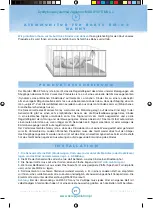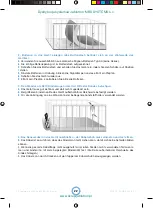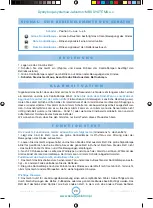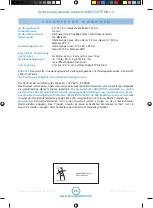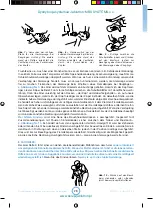
C h i l d E m e rg e n c y C a re G e n e r a l P ro c e d u re s
M F V 5 2 1 0 4 N AV- 0 3 2 . 0 4
18
Picture 7 –
Searching for the cor-
rect area for heart stimulation of an
infant. The second hand of the first-
aider should keep the head tilted
backwards to facilitate ventilation.
Picture 8 –
The position of hands
during the external heart stimulati-
on of a child. The second hand of
the first-aider keeps the tilted bac-
kwards to facilitate ventilation.
Picture 9 –
Hits between the spa-
tulas (up) and pressing the chest
(down) to remove a foreign item
from the breathing passages of an
infant baby.
described action, you must
thoroughly check the mouth, for any obstructions
(foreign item – e.g.
toy, food residues, etc.) or check the backward bend of the head and position of the bottom jaw.
If
the breathing passages are free and we can feel a pulse, perform rescue breaths at a frequency
of 20 breaths per minute.
❥
CHECK FOR SIGNS OF A CIRCULATION:
Take no more than 10 sec to:
Look for signs of a circulation. These include any movement, coughing, or normal breathing (not ago-
nal gasps - these are infrequent, irregular breaths) –
see pictures 5 and 6
. Check the pulse (if you are
trained and experienced)
but ensure you take no more than 10 sec to do this
:
In
a child over 1 year
— feel for the carotid pulse in the neck.
In
an infant
— feel for the pulse on the inner side of the upper arm.
If you are confident that you can detect signs of a circulation within 10 sec:
Continue rescue breathing, if necessary, until the child starts breathing effectively on his own.
Turn the child onto his side (into the recovery position) if he remains unconscious.
Re-assess the child frequently.
If there are no signs of a circulation, or no pulse, or a slow pulse, or you are not sure:
Start chest compression.
Combine rescue breathing and chest compression.
Picture 6 –
Pulse examination on
brachial artery.
Picture 5 –
Pulse examination on
the carotid artery.
Picture 4 –
Rescue breaths. (child).
The first-aider carefully covers the
mouth of the child with his own
mouth and uses one hand to keep
the head bent backwards and block
the nose of the child with his thumb
and forefinger.
Dystrybucja systemów Jablotron: MBS SYSTEMS s.c.
www.sklep-jablotron.pl


















